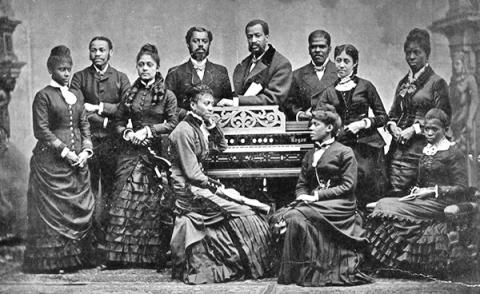A Short History of Southern Gospel

The original Fisk Jubilee Singers introduced ‘slave songs’ to the world in 1871 and were instrumental in preserving this unique American musical tradition known today as African American spirituals.
We enjoy the precision of the close 4-part harmony and inspirational messages in Southern Gospel music. But how did this form of music come about? The oldest tradition of Christian hymns was the singing of Old Testament Psalms. The earliest American Book of Psalms arrived with the Pilgrims in 1620. According to many of the histories written about Southern Gospel music, 1910 was the year that Southern Gospel was established as a separate, distinct genre of music. This was the year that J.D.Vaughan from Lawrenceburg TN formed the very first professional Southern Gospel quartet. But gospel music has roots that go back much further than that.
Gospel is characterized by close harmonies and a strong religious lyrical content. Most people think of gospel music as a southern phenomenon, but many music historians believe that the seeds actually sprouted in New England in 1734 when New England preacher Jonathan Edwards launched a religious revival known as the Great Awakening. The slow hymns of the time were not working for his passionate, upbeat services. The fervent preaching style and passionate music style of the Great Awakening traveled down the eastern coast to the southern states.
The similarities between the bondage of African Americans and that of Moses’ people inspired African Americans. They developed their own religious folk music. Once the Underground Railroad began to grow in popularity, slaves began to use their songs as codes. These secret codes were often hidden with a double meaning within the lyrics. “Going up yonder” meant going north. “Moses” was a name used for Harriet Tubman. “Swing Low, Sweet Chariot” referred to the Underground Railway. “Wade in the Water” had instructions for runaways to get into water if they heard bloodhounds. And a form of gospel music called the Jubilee Quartet was developed after the Emancipation.
Reworked hymns became African American spirituals and the first authentically American sacred music. These spirituals were influenced by early jazz and blues, the foundation for Black Gospel. Either the soloist or the choir answers or repeats the lyric just sung by the other. Mahalia Jackson (1911-1972) the Queen of Gospel Song, is probably regarded as one of the best Black Gospel singers of all time. Others included the Fisk Jubilee Singers, Clara Ward Singers, Roberta Martin Singers, Dixie Hummingbirds, Golden Gate Quartet, and the Soul Stirrers, among many others. They all helped to introduce and popularize this new musical style (initially rejected by ministers of denominational churches) for the Black masses through their live performances and regular broadcasts on local radio.
Thomas Andrew Dorsey (1899–1993) was known as “the Father of Black Gospel Music” and was at one time so closely associated with the field that songs written in the new style were sometimes known as “dorseys”. Dorsey’s gospel music combines Christian praise with the rhythms of jazz and the blues. His best-known composition, “Take My Hand, Precious Lord,” was performed by Mahalia Jackson and was a favorite of the Rev. Martin Luther King Jr. But after the 1970s, Black Gospel as a distinct form of its own ceased to develop.
In Part II, we will look at the development of Southern Gospel from shape note singing to today.
- Log in to post comments